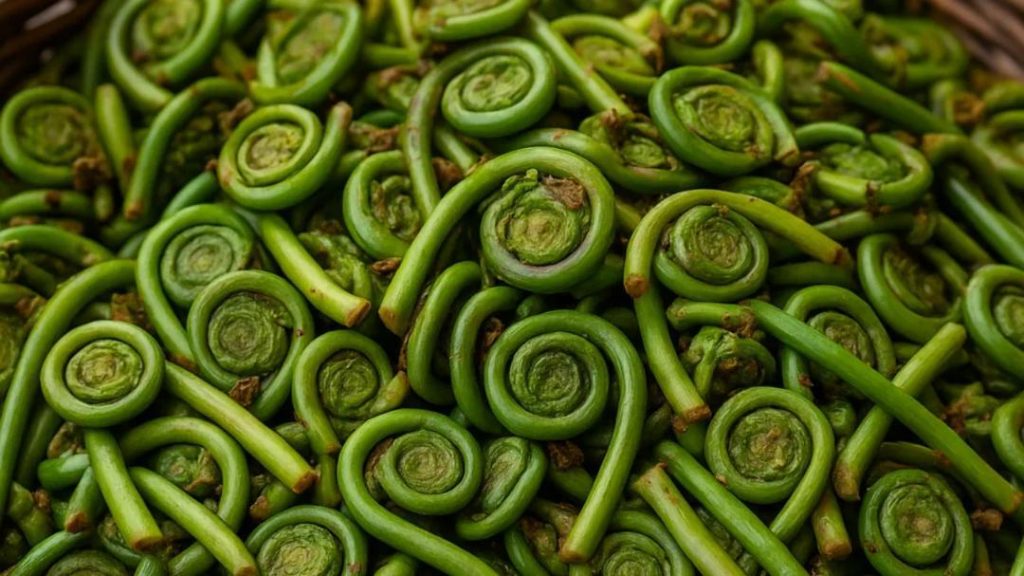
Lingad, a Monsoon Fern, Boosts Immunity and Bone Health
In the midst of the lush green forests of the Himalayas, a hidden gem awaits discovery. Lingad, also known as fiddlehead fern, is a young, coiled shoot that is foraged during the monsoon season. This delicacy has been a part of Indian cuisine for centuries, particularly in the northeastern regions. The locals call it Lengdu, Dhekia, or Nigro, depending on the region. But what makes Lingad so special? Let’s dive into the world of this unique and nutritious ingredient.
What is Lingad?
Lingad is the young, uncurled fronds of the Diplazium esculentum plant, a type of fern that thrives in the Himalayas. It is typically harvested when it is still tender and curled, before it matures and becomes fibrous and unfit for cooking. The fronds are then cooked and consumed as a vegetable, often sautéed with spices and herbs.
Unique Flavor and Texture
Lingad has a distinct, earthy flavor that is often described as a combination of asparagus and spinach. The texture is tender and slightly crunchy, making it a delight to eat. When cooked, Lingad retains its vibrant green color, making it a visually appealing addition to any dish.
Rich Tradition and Cultural Significance
Lingad has been an integral part of Indian cuisine for centuries, particularly in the northeastern regions. It is often consumed as a standalone dish or used as an ingredient in various recipes. The fern is also used in traditional medicine, where it is believed to have several health benefits.
Health Benefits
Lingad is densely packed with nutrients, including vitamins, minerals, and antioxidants. Some of the key health benefits associated with Lingad include:
- Boosts Immunity: Lingad is rich in vitamin C, which is essential for a healthy immune system. Vitamin C helps to boost the production of white blood cells, which fight off infections and diseases.
- Supports Bone Health: Lingad is an excellent source of calcium, vitamin K, and magnesium, which are essential for maintaining strong and healthy bones. Regular consumption of Lingad can help to reduce the risk of osteoporosis and fractures.
- Anti-Inflammatory Properties: Lingad contains anti-inflammatory compounds that can help to reduce inflammation and alleviate symptoms of conditions such as arthritis.
- Antioxidant-Rich: Lingad is rich in antioxidants, which help to protect the body from free radicals and oxidative stress. This can help to reduce the risk of chronic diseases such as cancer, heart disease, and neurodegenerative disorders.
How to Cook Lingad
Cooking Lingad is relatively simple. Here’s a basic recipe to get you started:
Ingredients:
- 100g Lingad fronds
- 2 tablespoons vegetable oil
- 1 onion, finely chopped
- 2 cloves garlic, minced
- 1 teaspoon grated ginger
- Salt, to taste
- Black pepper, to taste
- Fresh cilantro, for garnish
Instructions:
- Rinse the Lingad fronds under cold running water and pat them dry with a clean cloth.
- Heat oil in a pan over medium heat and add the chopped onion, minced garlic, and grated ginger. Cook until the onion is translucent.
- Add the Lingad fronds and cook for 5-7 minutes, or until they are tender and slightly caramelized.
- Season with salt and black pepper to taste.
- Garnish with fresh cilantro and serve hot.
Conclusion
Lingad, the monsoon fern, is a hidden gem that offers a unique flavor and texture, as well as several health benefits. This delicacy has been a part of Indian cuisine for centuries and is rich in nutrients and antioxidants. Whether you’re looking to boost your immunity, support your bone health, or simply add some excitement to your meals, Lingad is definitely worth trying.






